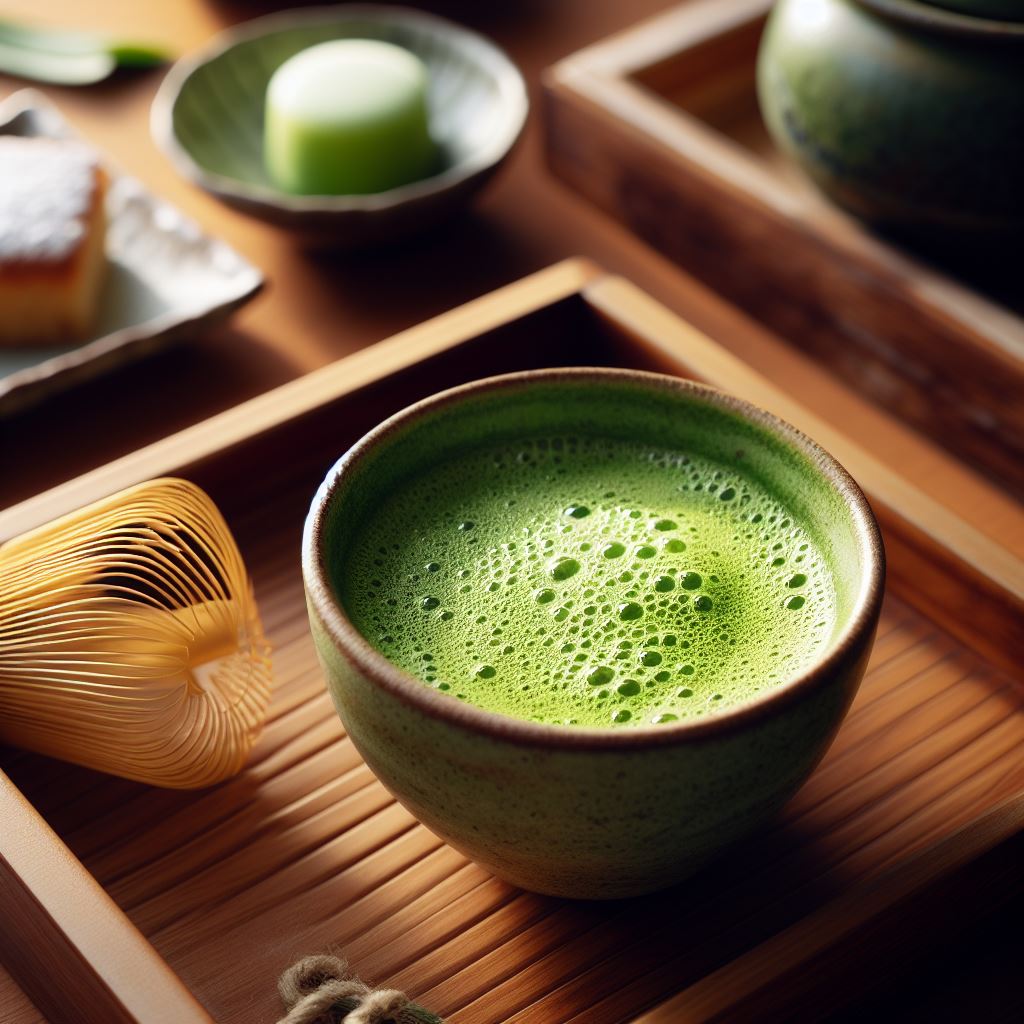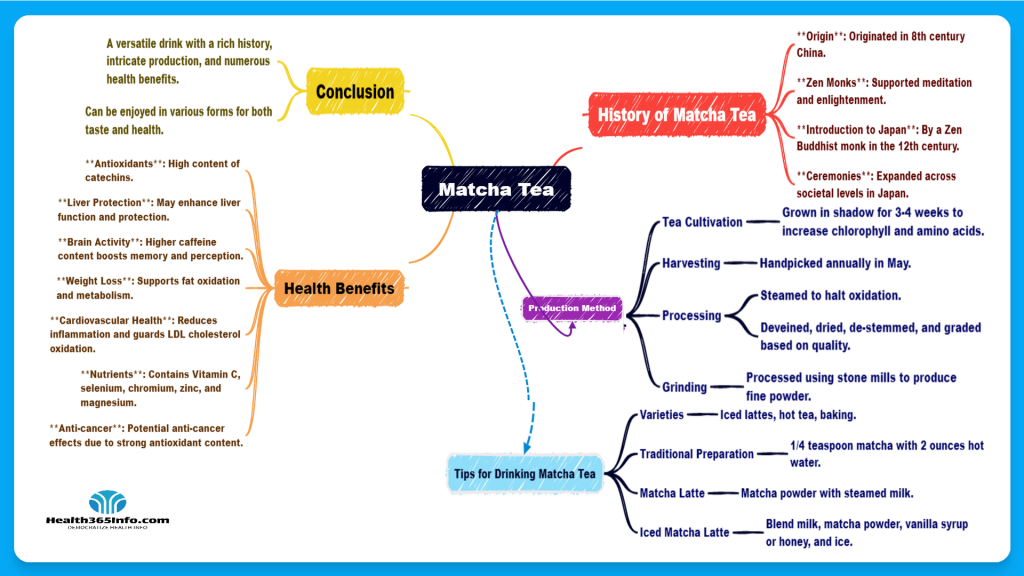
History of Matcha Tea
The preparation of powdered tea from dried tea leaves by steaming dates back to the 8th century in China, where matcha tea first gained popularity.
Matcha drinking became a Zen monk practice that not only supported their meditation efforts but also served as a means of actualizing enlightenment.
A Zen Buddhist monk who brought tea seedlings to Japan in the 12th century carried matcha with him.
Matcha tea ceremonies developed over time and expanded to all societal levels in Japan.
Production Method
The delicate and artistic method of making matcha tea includes the following steps:
Tea plants are raised in the shadow for three to four weeks before to harvest, which boosts the production of chlorophyll and amino acids.io
Hand Picked: Once a year, usually in May, the best matcha is manually collected.
Steamed and Air Dried: The oxidation process is stopped by steaming the tea leaves, which are then deveined and dried.
Graded and de-stemmed: The leaves are evaluated depending on quality after the stems and veins are cut out.
Matcha is made by grinding the leaves into a fine powder in stone mills.
Benefits of Matcha Tea for Health
Matcha tea has a wide range of health advantages, including the following:
High antioxidant content Catechins, a group of plant compounds that function as natural antioxidants and aid in the stabilization of dangerous free radicals, are abundant in matcha.
May work to safeguard the liver: According to several research, matcha tea may assist to safeguard the liver and improve overall liver function.
Increases brain activity Compared to other green teas, matcha has higher caffeine, which improves memory and perception.
Could aid in Weight Loss: Matcha tea has been demonstrated to help with weight loss by enhancing fat oxidation and metabolism.
Enhances cardiovascular health: Matcha tea’s antioxidants may enhance cardiovascular health by decreasing inflammation and guarding against LDL cholesterol oxidation.
Mineral and vitamin-rich: Vitamin C, selenium, chromium, zinc, and magnesium are among the vitamins and minerals found in matcha tea.
May have anti-cancer effects: Matcha tea’s strong antioxidant content may offer potential anti-cancer effects.
Tips for Drinking Matcha Tea
Matcha tea can be consumed in a variety of ways, including as iced lattes, regular hot tea, and even in baking dishes.
Simply combine 14 teaspoon of matcha powder with 2 ounces of hot water (ideally, 175°F), whisking until frothy, to produce traditional matcha tea.
To make a matcha latte, you can also add steamed milk of your choice.
Blend 12 oz of milk, 2 tsp of matcha powder, 2 tsp of vanilla syrup or honey, and 1 cup of ice to make a revitalizing iced matcha latte. In conclusion, matcha tea is a distinctive and adaptable drink with a lengthy history, a complex manufacturing method, and various health advantages. Matcha tea provides a tasty and healthy experience whether it is savored as a classic hot tea, a creamy latte, or used in recipes

KEY References
Yin, X. (2015). The effect of green tea intake on risk of liver disease: a meta analysis. PubMed Central (PMC). https://www.ncbi.nlm.nih.gov/pmc/articles/PMC4538013/
Dietz, C., Dekker, M., & Piqueras‐Fiszman, B. (2017, September 1). An intervention study on the effect of matcha tea, in drink and snack bar formats, on mood and cognitive performance. Food Research International; Elsevier BV. https://doi.org/10.1016/j.foodres.2017.05.002
Ide, K., Yamada, H., Takuma, N., Park, M., Wakamiya, N., Nakase, J., Ukawa, Y., & Sagesaka, Y. M. (2014, September 29). Green Tea Consumption Affects Cognitive Dysfunction in the Elderly: A Pilot Study. Nutrients; Multidisciplinary Digital Publishing Institute. https://doi.org/10.3390/nu6104032
Kochman, J., Jakubczyk, K., Antoniewicz, J., Mruk, H., & Janda, K. (2020, December 27). Health Benefits and Chemical Composition of Matcha Green Tea: A Review. Molecules; Multidisciplinary Digital Publishing Institute. https://doi.org/10.3390/molecules26010085
Xu, P., Ying, L., Hong, G., & Wang, Y. (2016, January 1). The effects of the aqueous extract and residue of Matcha on the antioxidant status and lipid and glucose levels in mice fed a high-fat diet. Food & Function; Royal Society of Chemistry. https://doi.org/10.1039/c5fo00828j
Janciauskiene, S. (2020, January 1). The Beneficial Effects of Antioxidants in Health and Diseases. Chronic Obstructive Pulmonary Diseases; COPD Foundation. https://doi.org/10.15326/jcopdf.7.3.2019.0152
Sokary, S., Al-Asmakh, M., Zakaria, Z. Z., & Bawadi, H. (2023, January 1). The therapeutic potential of matcha tea: A critical review on human and animal studies. Current Research in Food Science; Elsevier BV. https://doi.org/10.1016/j.crfs.2022.11.015
McNamee, G. L. (2022, October 21). Matcha | Origins, Uses, Japanese Green Tea Type, & Health Benefits. Encyclopedia Britannica. https://www.britannica.com/topic/matcha
All About Matcha. (n.d.). WebMD. https://www.webmd.com/food-recipes/ss/slideshow-all-about-matcha













